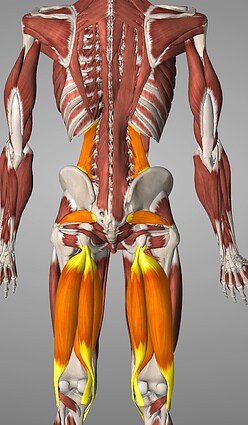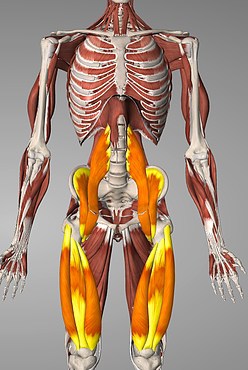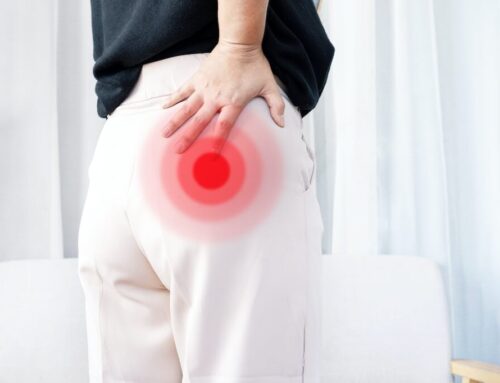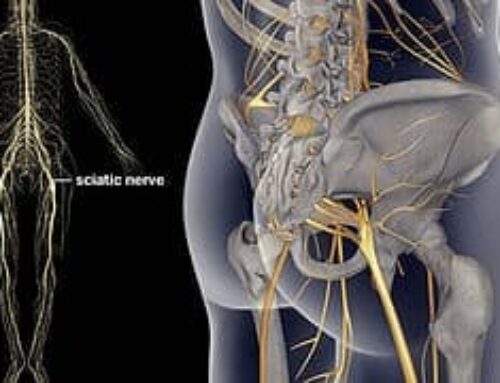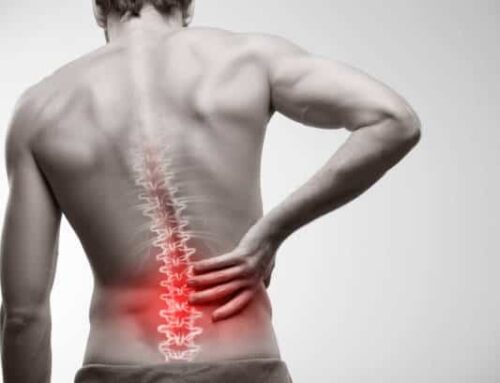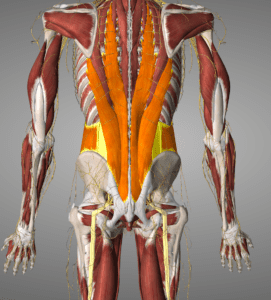
In this post we are discussing back pain or sciatica due to muscular or skeletal shock induced misalignment. These types of misalignments can alter the way that we move and lead to chronic repetitive injury that just never seems to heal.
Misalignment is fairly straightforward. The bones of your pelvis have a few degrees of freedom to rotate and should do so when you’re walking, running, or being active. In the case of misalignment, they have gotten stuck or pulled into a rotated or elevated position. How can this happen you ask? For shock induced misalignment it can be as simple as stepping off of a curb that was higher than expected, or thinking you’re at the bottom of the stairs, but that last one gets you and you hit the ground with a stiff leg and feel the shock all the way up into your hip and back. For muscular induced misalignments, faulty movement patterns could be to blame, or simply being inactive for most of the day and then jumping into athletics could prime our bodies to compensate. This misalignment if left unchecked can contribute to the development of back pain or sciatica.
When a misalignment occurs it can affect all of the muscles that surround the hip and pelvis. Think about it like this: the surface that a muscle has attached to all of its’ life is now in a slightly different position. The muscle does not quite know how to operate with this new alignment so it becomes less effective. When a muscle becomes less effective it’s common for the muscles that surround it to try to help out (compensate). So gradually they begin to overwork because now they’re picking up the slack for the other muscle and your muscles become imbalanced. Gradually this can cause several other problems depending on which muscles stiffen.
What happens when there is a skeletal induced misalignment?
In our experience this tends to happen more to females. This could be coincidence, but it is likely that the increased width of the hips and estrogen have something to do with it. The hips being wider means that higher loads may be transmitted through them on sudden impact through the foot. During periods of heightened estrogen production, the ligaments that surround the pelvis can become more elastic meaning that when a force is delivered to the pelvis, the bones are able to be shifted more easily. That being said it can happen to anyone, especially in the case of a fall or impact.
What happens with muscle induced misalignment?
The main difference between shock induced misalignment and muscle induced misalignment is how it happens. With shock induced there is usually an impact that jars the pelvis into rotation where it becomes stuck. With muscle induced misalignment you have a chicken or the egg type situation. Some research suggests that large muscle groups get over-active and overpower the weak muscle groups leading to the weak muscles slacking off. There is also research to suggest that the little guys slack off first and the large muscles feel the need to contract to compensate. It’s likely both, depending on the individual. Either way, the misalignment is caused by a muscular imbalance that affects the stability of a joint and therefore causes the body to move incorrectly. This pattern eventually leads to back pain or sciatica.
The Usual Suspects
There are 45 muscles that attach to the pelvis. Technically, any number of these muscles may be affected by a misalignment. The most common ones that we see as overactive or stiff in our practice are: Quadratus lumborum (QL), iliopsoas complex, piriformis, hamstrings, quadriceps, and TFL. There are also groups of muscles that become underactive, such as the multifidi or deep rotators of the hips.
Top to bottom: QL, Piriformis, Hamstrings
Top to bottom: Hip flexors, quadriceps
QL and Iliopsoas
Restrictions in the QL and iliopsoas often lead to flank pain (the area just above the glutes). By the time that you experience pain in this area it is often due to both muscular restriction and joint compression. These muscles being tight cause the lumbar spine to become compressed and they decrease the ability of the bones to move around one another. In more severe cases they can compress the spine to the degree that nerve roots get irritated, causing nerve pain, or sciatica, down the leg.
Piriformis
Restrictions in the piriformis can become problematic because over time the piriformis may irritate your sciatic nerve or the bursa at the side of your hip. A bursa is typically present to assist with decreasing friction between the bone and other moving tissues. In the case that it is compressed excessively it can give burning pain that runs down the side of your leg. The restriction in the piriformis affects how your hip moves and contributes directly to the further development of back pain or sciatica.
Hamstrings/Quadriceps
The hamstrings and quadriceps may stiffen up which can become particularly problematic for a couple of different reasons. The hamstrings being restrictive for particularly active people may potentially increase the occurrence of hamstring tendinopathy or tendon pain right at the buttock over your sit bone. The quadriceps over activity may contribute to increased compression of the patella against the femur and lead to patellofemoral pain, meniscus irritation, or bursitis at the knee. If the hamstrings and quadriceps are both overactive they may cause increased compression at the hip and restrict the hip and pelvis from working properly, leading to back pain. The mechanisms here are a little more in-depth than can be explained in this short blog post.
TFL
The TFL is a muscle at the front of your hip that attaches to your IT-band. It can completely alter the rotation of your femur as well as the ability of your hip and pelvis to work together correctly. With TFL over-activity it becomes more likely that you will have hip, knee, or low back pain.
What does treatment look like?
The treatment for these types of back pain or sciatica is dependent on each individual but the premise is simple. The most important part of treatment is to identify which muscles are stiff, and which are inactive. From there, realignment must be achieved. Once aligned, care must be taken to specifically re-activate and strengthen the correct muscle groups to perform the movements. Once muscle activation is achieved then true strength gains can be achieved to stabilize the alignment. This will also likely require a little brain work on your end to re-teach yourself how to move without compensating. As humans our bodies have adapted to take the path of least resistance. It will take some conscious effort on your end to make it so that the correct muscles can fire easily.
The method seems simple but the order is very important. Without alignment, you cannot teach the right muscles to fire, so identifying which type of misalignment is present is just as important as any other factor.
How do I know if I need this treatment for back pain or sciatica?
There are a few ways to identify if you’ll respond well to this treatment.
-
Do you get short term relief from adjustments/realignments or massage, acupuncture, or trigger point therapy?
-
Have you tried PT before and they had you just come in to do the same exercise program and you didn’t get better? How do you know if you’ve had good PT.
-
Do you feel like you’re always just tight?
-
Is there a lack of findings on imaging MRI, CT, or X-ray?
This post is not meant to be a tool for self diagnosis, it is simply to help those who have been seeking a solution to a long term problem to be able to identify if there is something they have not tried before that may be able to help their back pain or sciatica. Everyone presents differently so from this information it may be difficult to learn what you can do for yourself. If you think you may get benefit from this approach but want to discuss it further, please give us a call or fill out our contact form and we can set up a free 15 minute phone consultation.
With this approach we have had upwards of 80% success rates with people suffering from chronic hip and back pain and we would be thrilled to help you join the ranks as we seek to improve that rating.


